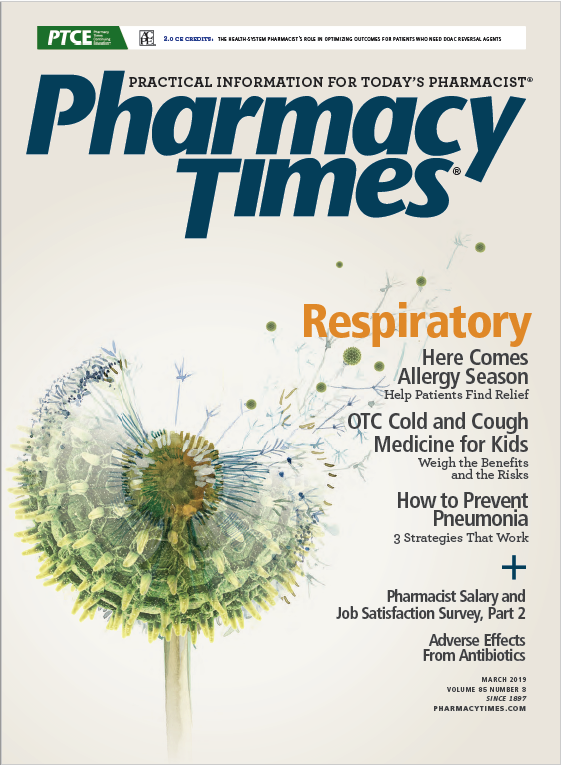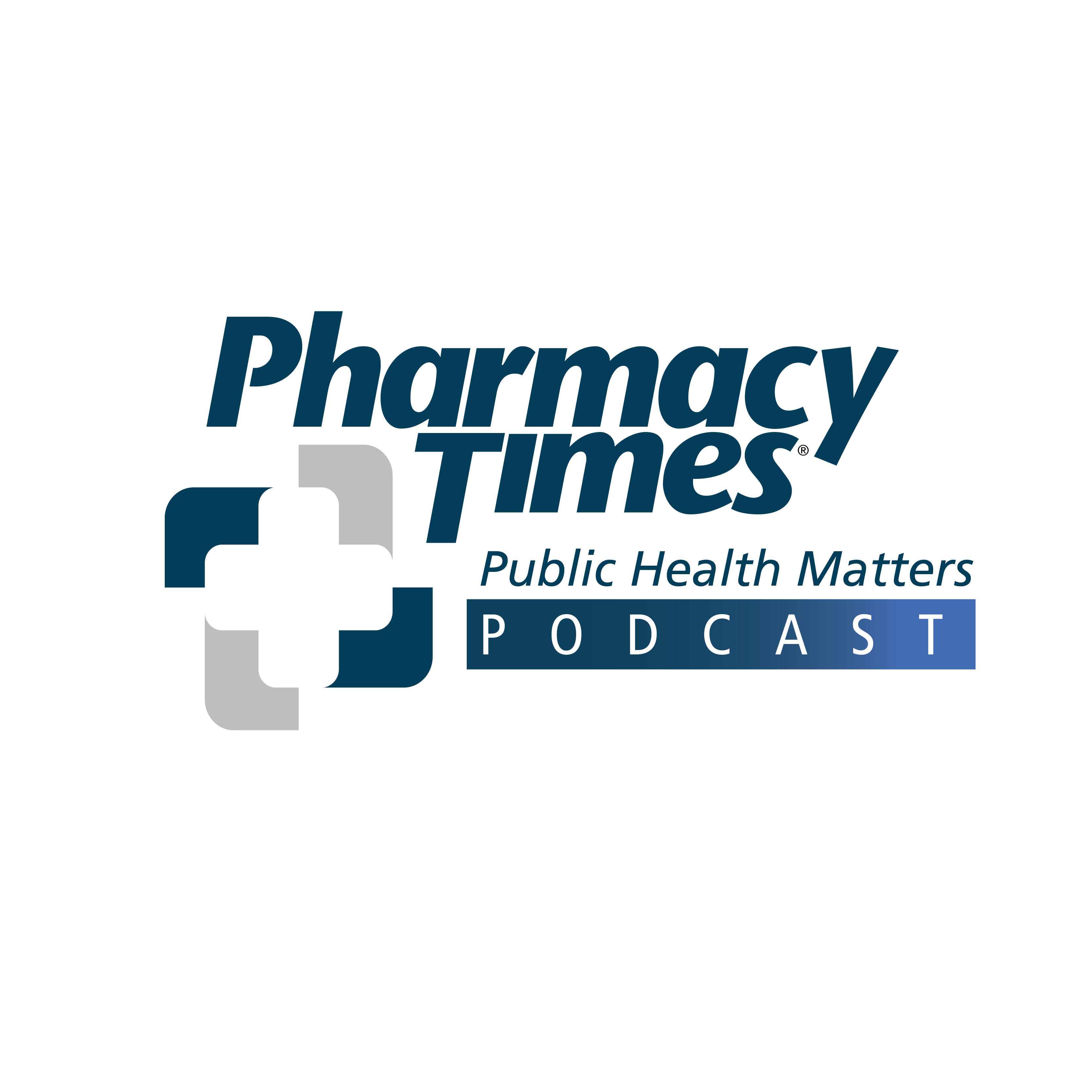Publication
Article
Pharmacy Times
Pneumonia Prevention Is Possible
Author(s):
A triad of techniques can reduce the likelihood of infection, and pharmacy teams can help patients with all of them.
Community-acquired pneumonia (CAP), an acute bacterial or viral alveolar lung infection, manifests in a clinical spectrum.
CAP can be walking pneumonia with anorexia, cough, dyspnea, and fever in otherwise healthy patients or so serious that it requires hospitalization (necrotizing or multilobar disease with septic shock). Pneumonia is the leading cause of death from infection in the United States and the eighth-leading cause of death, with influenza, and its incidence increases significantly during flu season (figure1,3).1,2 In the United States, influenza and respiratory syncytial virus are common causes of viral pneumonia. Streptococcus pneumoniaeis a common cause of bacterial pneumonia.3
RISK FACTORS
Anyone can contract pneumonia through direct contact with respiratory secretions, but certain risk factors increase the likelihood (see table1,3). It is noteworthy that influenza virus affects up to 20% of the general population each year. Pneumonia is a leading cause of death after influenza infection, especially in the elderly population and individuals with chronic illnesses or those who have concurrent comorbidities. Vaccination against the flu significantly reduces flu-and pneumonia-related hospitalizations, with a vaccine effectiveness of 25% to 53%. In the elderly population, vaccine effectiveness is lower. For this reason, pharmacists should recommend one of the highly immunogenic influenza vaccines for older adults.4,5
Many risk factors are well known, especially those associated with smoking and compromised pulmonary function. One that is underrecognized is acute stroke. About 10% of people who experience acute stroke develop pneumonia.6 Pneumonia in this population is usually hospital acquired and may be life-threatening. Risk factors include chronic obstructive pulmonary disease (COPD), congestive heart failure, coronary artery disease, dysphagia, higher stroke severity, male gender, older age, and pre-admission dependency.6 Prophylaxis with antibiotics seems to reduce the incidence of poststroke pneumonia, though study results are mixed.6,7 Pharmacists should also note an emerging factor: Individuals who are taking or have recently used a benzodiazepine appear to have 1.25 times the risk of contracting pneumonia of those who do not. Although the reason for the association is unknown, investigators suggest that relaxation of the esophageal sphincter and suppression of the immune system could increase pneumonia risk.8
A TRIAD OF PREVENTION TECHNIQUES
Three approaches can help prevent pneumonia, and pharmacy teams can help patients with all of them.
Smoking cessation is the most important action a patient can take to reduce the risk of CAP. Tobacco use impairs immune system and lung function and often leads to COPD and increases the risk of pneumonia. Helping patients quismoking is not easy, but with many different pharmacologic interventions available, pharmacists can recommend suitable products effectively.9
Healthy living practices can also prevent infection. These include cleaning surfaces that people touch regularly; coughing or sneezing into a sleeve or a tissue; managing ongoing medical conditions such as asthma, diabetes, and heart disease; and washing hands often and thoroughly. In addition, removing mold in homes and workplaces and improving cleanliness and ventilation can help. Regular exercise also improves lung health.1,3
IMMUNIZATION
The third intervention, vaccination, is critical. Children younger than 2 years should be vaccinated against S pneumoniae and Haemophilus influenzae with pneumococcal conjugate vaccine (PCV13) and against H influenzae type b. All healthy adults over 65 years who have not received a dose should be vaccinated with PCV13 and then schedule the pneumococcal polysaccharide vaccine at least 1 year later. The CDC also recommends immunization against pneumococcal pneumonia for smokers and those aged 2 to 64 years with chronic or immunocompromising medical conditions.10 This regimen is especially important for patients with COPD. Pneumococcal vaccine has been shown to reduce the likelihood of CAP and exacerbations of COPD. In addition, the annual influenza vaccine reduces the likelihood of complications from the flu, including pneumonia.11,12
CONCLUSION
In 2016, the CDC reported 13.5 deaths per 100,000 Americans from influenza and pneumonia,13 the lowest rate ever reported, down from 53.7 per 100,000 before 1960 and 23.7 in 2000.13 But this number is still too high. Pharmacists can help reduce infection by recognizing that pneumonia is a life-threatening illness, addressing smoking proactively, encouraging vaccination, and reminding patients that the flu and pneumonia are linked.
Jeannette Y. Wick, RPh, MBA, FASCP, is an assistant director of the Office of Pharmacy Professional Development at the University of Connecticut School of Pharmacy in Storrs.
REFERENCES
- Waterer GW, Rello J, Wunderink RG. Management of community-acquired pneu- monia in adults. Am J Respir Crit Care Med. 2011;183(2):157-164. doi: 10.1164/ rccm.201002-0272CI.
- CDC, National Center for Health Statistics. Leading causes of death. CDC website. cdc.gov/nchs/fastats/leading-causes-of-death.htm. Updated March 17, 2017. Accessed January 3, 2019.
- Pneumonia can be prevented—vaccines can help. CDC website. cdc.gov/pneumonia/prevention.html. Updated October 18, 2018. Accessed January 3, 2019.
- Heo JY, Song JY, Noh JY, et al. Effects of influenza immunization on pneumonia in the elderly. Hum Vaccin Immunother. 2018;14(3):744-749. doi: 10.1080/21645515.2017.1405200.
- Ballinger MN, Standiford TJ. Postinfluenza bacterial pneumonia: host defenses gone awry. J Interferon Cytokine Res. 2010;30(9):643-652. doi: 10.1089/jir.2010.0049.
- Badve MS, Zhou Z, van de Beek D, Anderson CS, Hackett ML. Frequency of post- stroke pneumonia: systematic review and meta-analysis of observational studies. Int J Stroke. 2019;4(2):125-136. doi: 10.1177/1747493018806196.
- Badve MS, Zhou Z, Anderson CS, Hackett ML. Effectiveness and safety of antibiotics for preventing pneumonia and improving outcome after acute stroke: systematic review and meta-analysis. J Stroke Cerebrovasc Dis. 2018;27(11):3137-3147. doi: 10.1016/j.jstrokecerebrovasdis.2018.07.001.
- Sun GQ, Zhang L, Zhang LN, Wu Z, Hu DF. Benzodiazepines or related drugs and risk of pneumonia: a systematic review and meta-analysis [published online January 8, 2019]. Int J Geriatr Psychiatry. doi: 10.1002/gps.5048.
- San-Juan-Rodriguez A, Newman TV, Hernandez I, et al. Impact of community pharmacist-provided preventive services on clinical, utilization, and economic outcomes: an umbrella review. Prev Med. 2018;115:145-155. doi: 10.1016/j.ypmed.2018.08.029.
- Immunization schedules. CDC website. cdc.gov/vaccines/schedules/index.html. Updated February 5, 2019. Accessed February 14, 2019.
- Kislaya I, Rodrigues AP, Sousa-Uva M, et al. Indirect effect of 7-valent and 13-valent pneumococcal conjugated vaccines on pneumococcal pneumonia hospitalizations in elderly. PLoS One. 2019;14(1):e0209428. doi: 10.1371/journal. pone.0209428.
- Song JY, Noh JY, Lee JS, et al. Effectiveness of influenza and pneumococcal polysaccharide vaccines against influenza-related outcomes including pneumonia and acute exacerbation of cardiopulmonary diseases: analysis by dominant viral subtype and vaccine matching. PLoS One. 2018;13(12):e0207918. doi: 10.1371/journal. pone.0207918.
- Deaths by influenza and pneumonia in the U.S. from 1950 to 2016 (per 100,000 population). Statista website. statista.com/statistics/184574/deaths-by-influenza-and- pneumonia-in-the-us-since-1950/. Accessed February 14, 2019.







